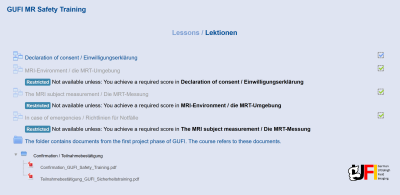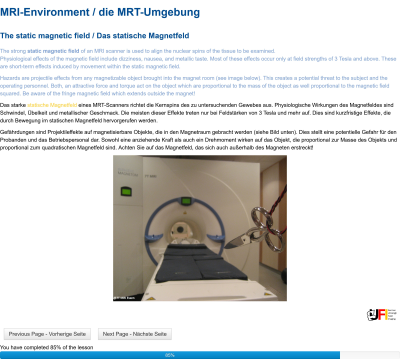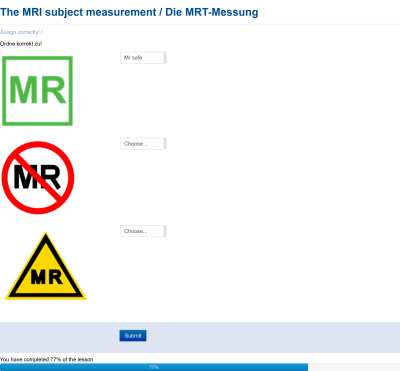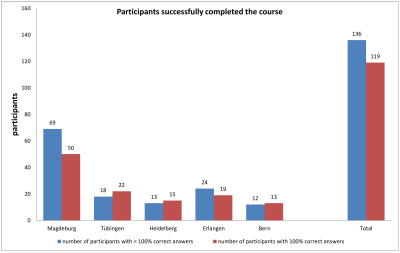4168
On the successful implementation of a first homogenized multicenter online safety training for ultrahigh field MRI1Biomedical Magnetic Resonance, Otto-von-Guericke University, Magdeburg, Germany, 2Erwin L. Hahn Institute for Magnetic Resonance Imaging, University Duisburg-Essen, Essen, Germany, 3German Center of Neurodegenerative Diseases - DZNE, Magdeburg, Germany, 4Leibniz Institute for Neurobiology, Magdeburg, Germany, 5High-Field and Hybrid MR Imaging, University Hospital Essen, Essen, Germany, 6Medical Physics in Radiology, German Cancer Research Center - DKFZ, Heidelberg, Germany
Synopsis
One of the main tasks of the German Ultrahigh Field Imaging (GUFI) network was the establishment of a uniform online MRI safety training, created in cooperation with all German ultrahigh field (UHF) sites. Implemented with Moodle, the course provides basic MRI safety training and includes three lessons: "MRI Environment", "Subject Measurements" and "In Case of Emergencies". Participants have to pass tests, consisting of appropriate questions, at the end of each lesson. In total, 255 participants have successfully completed the course (since April 2018).
INTRODUCTION
We report on the successful implementation of a first homogenized multicentre online safety training for UHF MRI and first results on participant numbers and success rates. At present, ten human MRI systems with 7 Tesla and 9.4 Tesla are installed in Germany. However, limited resources for preparing, supporting, and conducting studies with external users as well as lack of coordination to reconcile the interests of users with the provider's capabilities, and a lack of standard procedures, regulations and legal framework to work with these investigational devices are challenges common to all UHF sites. Therefore, a network called German Ultrahigh Field Imaging (GUFI)1 was established to create and promote a nationwide network of UHF MRI sites as a first step. This network facilitates communication between all UHF MRI sites in Germany to advance joint research and recommends rules of access to UHF MRI systems for scientists. One of the most important goals of GUFI is to establish an online platform for MRI safety training, acknowledged by all GUFI sites. The federal German Medical Devices Act2 together with the Medical Devices Operator Regulation3, which regulate MRI devices, requires that every institution operating such devices gives a safety briefing as a precondition to work with MRI. At all German UHF MRI laboratories, PIs, medical technical assistants, physicians, and other persons accompanying studies must participate annually in such a safety briefing. In this abstract we report and discuss quantitative results of the first year of the online MRI safety training.MATERIALS AND METHODS
We selected the open source learning platform Moodle4 as a framework for implementing the online safety course. The course is hosted in the Moodle system at the University Duisburg-Essen (UDE). The access is not restricted to UDE members, but also available to any other person. The course offers a basic MRI safety training consisting of three lessons: “MRI Environment”, “Subject Measurements” and “In Case of Emergencies” (Fig.1). The safety training is currently available in German and English (Fig.2). To successfully complete the course, the user has to work through all three lessons and pass test questions at the end of each lesson (Fig.3). Course content and test questions have been compiled based on the safety instruction held in Magdeburg together with supplements from the other GUFI sites.The number of trials for the test at the end of each lesson is currently not limited. We will report on the number of participants and success rates.RESULTS
In April 2018 the GUFI MRI safety course5 had its official start. Until mid of October 2019 the total number of participants has accumulated to 363. The diagram (Fig.4) shows the numbers of participants from actively participating sites (with more than 10 participants), adding up to a total of 255 persons who completed. So far all participants have passed the test and thus demonstrated their successful participation in the safety instruction.To pass the test, 90 % correct answers must be achieved in the first lesson, 80 % for the second and third lesson (Fig.5). Which means only one question per lesson can be answered incorrectly; very few participants needed up to three repeats. Between 42 % and 55 % of the participants at each site were able to pass the tests without errors in the first attempt. In Magdeburg, this year’s oral safety instruction in an auditorium was replaced entirely by the GUFI online training. GUFI has received requests from partnering communities in France, the United Kingdom and Israel to either get access to the course or create further language versions. From all participating sites we received positive feedback, with some providing valuable suggestions which we have already incorporated into the course.DISCUSSION AND CONCLUSION
GUFI successfully implemented and now provides an online MRI safety training. The GUFI course is in routine use in Magdeburg and at the other sites listed in the diagram (Fig.4). From our point of view, establishing an online platform for MRI safety training, including examination questions to verify attainment of training goals, offers several advantages:- A uniform MRI safety training at all UHF sites and the mutual recognition by all GUFI sites eases the burden on researchers and instructors (only local details need to be trained on site).
- New employees get access to UHF laboratories independent of time-consuming and irregular, local oral offerings.
- The major advantage of the online course in contrast to an oral course is that it not only provides safety information but also tests understanding of course content. This potentially increases safety when working in UHF MRI environments, not only for personnel but also for volunteers and patients. In addition, active participation and comprehension of the users is documented, rather then only physical presence.
Acknowledgements
This work was supported by the DFG (LA 1325/7-1 | QU 154/5-1 | SP 632/9-1) and the participating UHF sites.References
1. https://mr-gufi.de
2. MPG: Gesetz über Medizinprodukte, 2017, http://www.gesetze-im-internet.de/mpg/
3. MPBetreibV: Verordnung über das Errichten, Betreiben und Anwenden von Medizinprodukten, 2017, http://www.gesetze-im-internet.de/mpbetreibv/
4. https://moodle.org/
5. https://moodle.uni-due.de/course/view.php?id=12066




